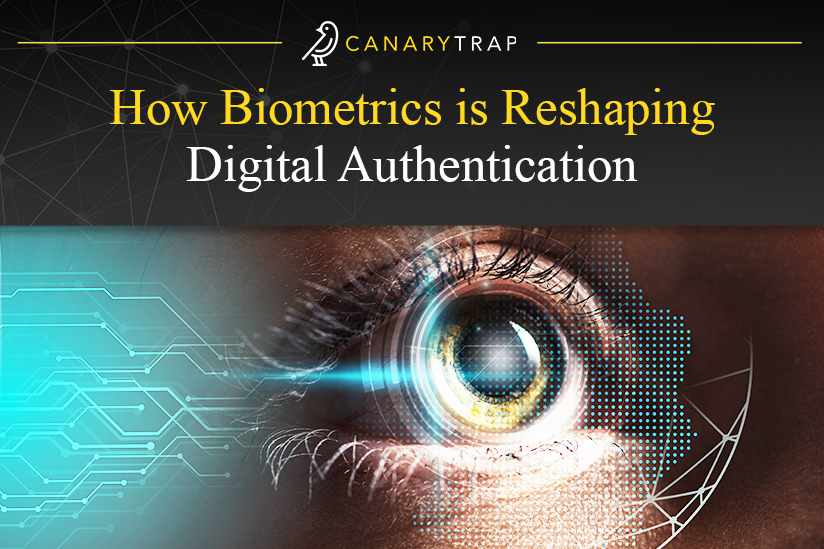How Biometrics is Reshaping Digital Authentication
- February 5, 2024
- Canary Trap
In an era where digital threats constantly evolve, the demand for robust cybersecurity measures has never been more pressing. One innovative solution at the forefront of this defense is biometric authentication. Traditionally confined to the realms of science fiction, biometrics has seamlessly transitioned from the pages of futuristic novels to the reality of our digital landscape.
As we navigate the intricate maze of cybersecurity challenges, the role of biometrics stands as a beacon of promise. From unlocking smartphones with a fingerprint to passing through airport security with facial recognition, biometrics has revolutionized the way we secure and access our digital and physical spaces.
In this exploration of biometric authentication, we delve into its fundamental principles, the diverse landscape of biometric systems, the challenges that accompany their implementation, and the promising future that awaits. Join us on this journey as we decipher the language of fingerprints, retinas, and facial features, unraveling the layers of security woven into the very fabric of our identities.
What Are Biometrics?
Biometrics refers to the measurement and statistical analysis of people’s unique physical and behavioral characteristics. These characteristics are used to identify and verify individuals, providing a reliable method for authentication and access control in various applications.
When authentication is required, the person’s biometric data is captured again and the system compares it with the stored template to determine a match. Biometrics is widely used for various applications, including access control to secure facilities, unlocking devices like smartphones, identity verification in financial transactions, and enhancing overall cybersecurity measures.
Biometrics experts at RecFaces make the distinction that: “while biometric security systems can combine identification and authentication, the two functions are not the same. With biometric identification, a person’s features are compared to an entire database. With biometric authentication, on the other hand, the system is checking to see if the person is who they say they are — so their attributes are compared against one particular profile from the database.”
Biometrics stands as a revolutionary paradigm in cybersecurity, leveraging intrinsic human characteristics for robust authentication. In the dynamic landscape of cyber threats, traditional authentication methods like passwords or PINs often fall short in providing airtight security. Biometrics, however, introduces a formidable layer of protection by tapping into unique physical and behavioral traits, ensuring a more personalized and secure user verification process.
Types of Biometrics Systems
Biometric systems capture and analyze specific traits, which can be physiological or behavioral. The landscape of biometric systems is diverse, encompassing various modalities to capture and analyze distinct aspects of an individual’s identity. Common physiological biometrics include:
- Fingerprint Recognition: One of the most prevalent forms is fingerprint recognition, which analyzes the intricate patterns on an individual’s fingertips. This modality is not only widely recognized but also ingrained in everyday use, seen in mobile devices and secure entry systems.
- Facial Recognition: Another prevalent modality. It delves into the distinct features of a person’s face, offering a seamless and contactless means of authentication.
- Iris and Retina Scans: Focusing on the unique patterns in the eye, they can also provide a level of precision that is particularly crucial in high-security environments.
- Voice Recognition: It transforms vocal distinctiveness into a robust layer of identity verification. Capturing pitch, tone, and cadence, it offers a user-friendly and continually evolving form of security.
Behavioral Aspects
Beyond physiological characteristics, behavioral biometrics add another layer to the authentication process. Analyzing behavioral traits such as keystroke dynamics – the unique rhythm and pressure applied while typing – or gait analysis – the distinct way an individual walks – further refines the identification process.
According to TechTarget, “Some of these behavioral identifiers can be used to provide continuous authentication instead of a single one-off authentication check. While it remains a newer method with lower reliability ratings, it has the potential to grow alongside other improvements in biometric technology.” These behavioral aspects enhance the overall accuracy of biometric systems, creating a holistic and intricate understanding of an individual’s identity.
What’s the Role of Biometrics in Cybersecurity?
In the realm of cybersecurity, where identity theft and unauthorized access pose significant threats, the role of biometrics becomes paramount. Traditional authentication methods, often reliant on static credentials, can be compromised through various means. Biometrics, however, offer a dynamic and adaptive solution. By incorporating unique biological markers or behavioral cues, biometric systems fortify digital identities, making it exceptionally challenging for malicious actors to exploit or manipulate authentication processes.
Moreover, the adoption of biometric authentication aligns with the growing need for user-friendly yet secure methods. Traditional passwords, burdened by the challenge of creating and remembering complex combinations, give way to biometric systems that offer a more intuitive and convenient experience. Users find themselves seamlessly authenticated through a simple touch, glance, or voice command, enhancing both security and user satisfaction.
In an article published in LifeWire, it was mentioned that “biometric traits are far more difficult to hack, steal, or fake. This is one reason why biometrics are often favored for high-level secure entry (e.g. government/military buildings), access to sensitive data/information, and the prevention of fraud or theft. Characteristics used by biometric identification/authentication are predominantly permanent, which offers a convenience — you can’t simply forget or accidentally leave them somewhere at home.”
As we navigate the intricate landscape of biometrics, the convergence of diverse modalities and behavioral analytics underscores its versatility and adaptability. This multifaceted approach not only strengthens cybersecurity defenses but also sets the stage for a future where secure, user-centric authentication becomes the norm.
Challenges of Biometric Authentication
While biometric authentication offers a robust defense against many cybersecurity threats, it is not without its challenges. In the book Smart Cities Cybersecurity and Privacy, authors explain that “while biometrics such as fingerprints, iris scans, and facial images are private, they are not secret. We leave a copy of our fingerprints on almost everything we touch. A modern smartphone is capable of taking high-resolution pictures of our faces from which the iris biometrics can be extracted. Thus, unless we spend our life wearing gloves and shades, there is no hope that our biometrics can be kept secret.”
In order for biometrics technology to continue advancing towards a widespread adoption in cybersecurity, acknowledging and addressing these challenges is crucial, including:
- Privacy Concerns
One of the primary challenges associated with biometric authentication is the concern over privacy. Collecting and storing biometric data raises apprehensions about how this sensitive information is handled, stored, and protected. Ensuring stringent privacy measures, such as encryption and secure storage practices, becomes imperative to alleviate these concerns. Regulatory frameworks, like GDPR, play a pivotal role in establishing guidelines for the ethical and lawful use of biometric data.
- Biometric Spoofing
Biometric systems are not immune to spoofing attempts, where malicious actors try to replicate or manipulate biometric data to gain unauthorized access. For instance, fingerprint sensors may face challenges posed by high-quality fake fingerprints. Continuous advancements in anti-spoofing technologies, such as liveness detection and multi-factor authentication, are essential to thwart these deceptive efforts.
- Standardization and Interoperability
The absence of universal standards for biometric data formats and communication protocols can hinder interoperability between different systems and devices. Establishing industry-wide standards promotes seamless integration, ensuring that biometric solutions work cohesively across diverse platforms and applications.
Addressing Common Misconceptions About Biometrics
Despite the transformative impact of biometric authentication, several misconceptions surround its implementation and effectiveness. Addressing these myths is crucial for fostering accurate understanding and promoting wider acceptance of this technology.
- “Biometrics Are Infallible”
While highly accurate, biometric systems are not immune to errors. Factors like poor image quality or environmental conditions can impact their reliability.
- “Biometric Data Is Stored as Images”
Biometric systems do not store actual images of fingerprints or faces. Instead, they create templates using mathematical algorithms, ensuring privacy and security.
- “Biometric Systems Are Complex and Inconvenient”
Advances in technology have streamlined biometric integration, making it user-friendly and convenient. Users often find it quicker than entering passwords or PINs.
- “Biometrics Can Be Easily Replicated”
Biometric systems employ sophisticated algorithms and encryption, making it extremely challenging to replicate or forge biometric data.
By dispelling these misconceptions, we pave the way for a more accurate perception of biometric authentication, encouraging its responsible and effective implementation in various sectors.
What Does the Future Look like for Biometrics in Cybersecurity?
The trajectory of biometrics in cybersecurity points towards a significant increase in adoption. Several factors contribute to this anticipated growth:
- Advancements in Technology
Continual advancements in biometric technology, including improved accuracy, anti-spoofing measures, and faster processing, contribute to its growing acceptance. As technology evolves, biometric systems become more sophisticated and reliable.
- Proliferation of Biometric-enabled Devices
The widespread integration of biometric features in smartphones, tablets, and other devices contributes to user familiarity and comfort with this authentication method. As more devices incorporate biometrics, its usage becomes more commonplace.
- Regulatory Support
Increasing awareness of cybersecurity threats has prompted regulatory bodies to support and encourage the adoption of secure authentication methods like biometrics. Regulatory frameworks provide guidelines for ethical data use and security practices, fostering trust in biometric systems.
- Multi-Modal Biometrics
The future of biometrics lies in the integration of multiple biometric modalities. Combining facial recognition with fingerprint scans or behavioral analytics creates a multi-modal approach that enhances accuracy and resilience against spoofing attempts.
In Conclusion
As we stand at the intersection of technological innovation and cybersecurity challenges, biometric authentication emerges not just as a solution but as a transformative force shaping the future of secure digital interactions. Biometrics stands not only as a shield against evolving cyber threats but as a paradigm shift in user-centric authentication.
The role of biometrics in cybersecurity is paramount, offering a dynamic and adaptive solution in a landscape rife with identity theft and unauthorized access. Its user-friendly nature, seamlessly replacing passwords with intuitive touches or glances, not only enhances security but also user satisfaction.
The diverse landscape of biometric systems, from fingerprint recognition to behavioral analytics, underscores the adaptability and versatility of this authentication approach. However, challenges such as privacy concerns and the need for standardization must be addressed to ensure responsible and effective implementation.
Looking to the future, the trajectory of biometrics in cybersecurity is marked by advancements in technology, regulatory support, and the proliferation of biometric-enabled devices. Embracing the power of fingerprints, retinas, and behavioral patterns, biometrics opens doors to a safer and more connected world, where individuals can navigate the digital landscape with confidence and trust.
SOURCES:
- https://recfaces.com/articles/biometric-security#:~:text=biometric%20information%20database.-,Why%20is%20biometric%20security%20so%20difficult%20to%20defeat%3F,anti%2Dspoofing%20technology%20built%20in
- https://www.techtarget.com/searchsecurity/definition/biometrics
- https://www.lifewire.com/biometrics-4154702
- https://www.sciencedirect.com/book/9780123743541/computer-and-information-security-handbook

